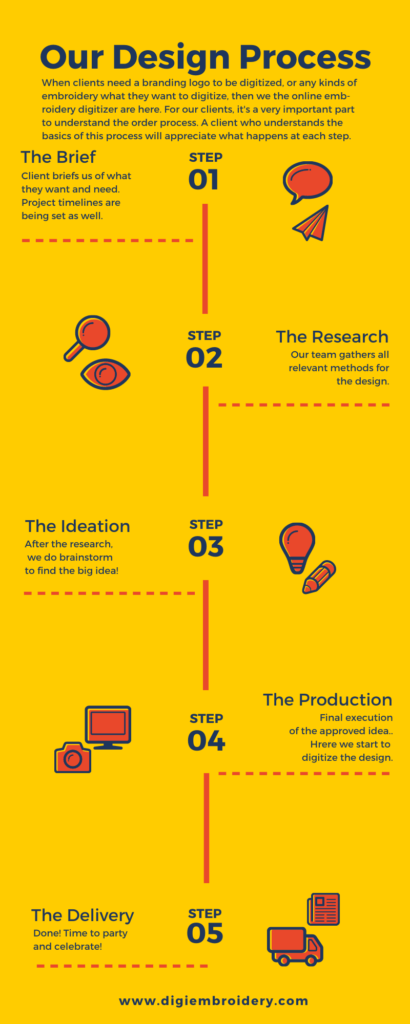Various Tools of Digitizing of Embroidery ( It’s all about Embroidery)
- 3D Embroidery (Three Dimensional): Another name of 3D embroidery is Puff Embroidery. It is a very unique technique to give three-dimensional looks to embroidery. A layer that is made of foam is placed under the area where your desired design will be embroidered. A very high stitch solidity is used to cut the foam for easy removal, and the foam under the design will not be shown.
- Appliqué: Appliqué is a French term and it’s meaning is applying. The Trimming or the Decoration cut from one piece of yarn or fabric and stitched to others to add dimension and weaving and minimizes the count of stitches.
- Backing: Knitted or non-knitted material used underneath the fabric being embroidered to provide more support and the best stability for the needle penetration. It’s Best used when It is hooped with the garment, but can also be moved between the item to be embroidered and the needlepoint on flatbed machines. It is available in various styles and weights with two basic types – Cutaway and Tearaway.
- Bean Stitch: Three (3) stitches placed back and forth between 2 points. It is usually used for outlining. Because it’s work is eliminating the requirements for repeatedly digitizing a single-ply running stitch outline
- Birdnesting (Birdnest, Birds Nest): Procurement of yarn caught between the embroidered item and the needle plate usually caught in the needle plate hole and hook assembly. The Formation of a birdnest prevents it’s from the free movement of goods and may be caused by inadequate tensioning of the top yarn, top yarn not through the take-up lever, top yarn not following the yarn path correctly, or flagging goods.
More Tools for Digitizing of Embroidery
- Bobbin: Spool or reel that keeps the thread used to form the underside stitching. Bobbin yarn works with upper yarn to make stitches. (Check our Facebook page)
- Bobbin Case: Small, round metal tools or devices for holding the bobbin. It is used to tension the bobbin yarn, and it is being inserted in the hook for sewing again.
- Boring: Embroidered clothes or any kind of goods that have been punctured with a sharp-pointed tool known as a bore, the edges of the hole generated by the bore are embroidered, the hole is enlarged by the embroidery. (check our free embroidery designs)
- Buckram or Buckram Lining: Stiffened with glue, woven fabric, Coarse, and used to stabilize thread for stitching. It is Generally used in caps to hold the front panel erect.
- Chain Stitch: It’s a Stitch that presents a link chain, formed with one yarn fed from the bottom side of the fabrics. It is done on a manual machine or computerized with a hook that functions as a needle.
- Chenille: It is technically placed in appliqué and athletic applications characterized by a design surface comprised of heavy loops of yarn and sewn with heavy needle threads, chenille is created on specialized embroidery equipment.
- Column Stitch: It is usually used to form borders all the around filled areas and also for rendering text and the column stitch what is consists of thin spaced satin stitches.

Software of Digitizing of Embroidery
Compensation: The technique of digitizing embroidery used to compensate/counteract the distortion (push or pull ) caused by the needle interaction, yarn, machine tensions, and backing and it is also a programmable feature.
Complex Fill: It is similar to standard fill. It refers to the technique of digitizing embroidery that allows digitizer to ‘knock out’ area or areas within fill, creating openings or negative space (visualize Swiss cheese). The design can be digitized as one filled area, instead of being broken down into several sections.
Condensed Format: The method of digitizing embroidery, where a design is saved in a skeletal form, so a proportional number of stitches may be placed between defined points after a scale has been designated. If an embroidery machine can operate or read condensed format, density, the scale and stitch lengths in a design may be changed.
Cutaway: Cutaway is one of the two basic types of backing materials. And the other type is Tearaway.
Density: Density means the number of stitches in an earmarked area. It also determines the coverage of total yarn in a design.
Digitizing or Embroidery of Digitizing: It is the modern term for punching. It is the procedure of taking any form of artwork and transforming the design into a language so that it can be understandable by the commercial embroidery machine or home sewing machine and stitch it out. The digitizing of embroidery is a very difficult process that uses stitch or thread types including running stitch, satin stitch, and fill stitch to create an embroidery design. It needs many steps from starting with simple clip art to a stitched out design. The Software of embroidery digitizing is needed for this process. Most of the software vendors often advertise auto-digitizing capabilities.
Embroidery Digitizer or Digitizer: A person who creates or generates embroidery designs is known as Digitizer or Puncher or an Embroidery Digitizer. A puncher uses digitizing software to generate an object-based embroidery design, which can be easily reshaped and edited. These files keep very important information such as the outlines of an object, yarn colors, and the original artwork that is used to punch the designs. When the file is converted into a stitch file, it loses very much of its information, rendering editing difficult or impossible.
Digitizing Tablet: The tablet of digitizing is the surface on which actual artwork to be digitized is placed, and it holds the artwork flat, then allowing the puncher to specify different kinds of designs characteristics by ‘tracing’ and otherwise designating them with a digitizing ‘puck’ (it’s similar to an input device, a computer mouse).

Editing: The changing aspects of a design via a computerized editing function. Most functions or programs allow the user to scale the designs up-down, and edit block by block or stitch by stitch, then merge lettering with the design, move the aspects of the design around, and insert or edit the commands of the machine.
Emblem: Other names of Emblem are “Crest” or “Patch”. The finished edge of an embroidery design, commonly a mark of an identification, usually worn on outer clothing, and the most important, historically, an emblem always carried a motto, verse, or suggested a moral lesson.
Embroidery: It refers to a Machine Embroidery here, or more specifically, Computerized Machine Embroidery. It is a process where an embroidery machine is controlled by a computer, is used to create patterns on textiles. It is used in product branding commercially, corporate advertising, and adornment of the uniform. There are so many hobbyists that also do some machine embroidery for personal sewing and craft projects. Nowadays most modern or digital embroidery machines are equipped with computers precisely engineered for embroidery.
These machines range from single-needle, single-head sewing machines for home or personal usage and hobbyists, and to commercial and industrial embroidery machines that are multi-headed (6 to 20 heads are common), with multi-needles (9 to 15 are common) under each head, depending on their capabilities and usages. They all have a framing system that holds the framed area of fabric taut under the sewing needle(s) and let it moves to make a design from a pre-programmed digitizing file prepared by a puncher.
Expanded Format: It is a design program or function where separate stitches in a design have been precisely digitized for a certain size. Designs that digitized in this format cannot usually be enlarged or a little more than 10 to 20 percent without distortion because stitch count remains constant.
File Format: The most important part of embroidery digitizing and this is embroidery file formats and it broadly falls into two categories. (1) Source Formats: It is specific to the software used to create the design and for these formats, the puncher keeps the original file for editing purposes. (2) Machine Formats: It is specific to a particular brand of machine embroidery and these machine formats normally contain stitched data (offsets) and machine functions (trims, jumps, etc.) and are not easily scaled or edited without extensive manual work.
Fill Stitch or Fill: Another name of Fill stitch is Tatami stitch. Generally large design area or vast design area covered by a series of running stitches, the pattern of which may be different in terms of lengths of stitches, angles, and density.
Frame: It may employ a number of means for sustaining stability during the process of embroidery, including clamps, magnets or springs, vacuum devices. It is holding a device for inserting goods under an embroidery head.
Lettering: In digitizing of embroidery, there are several uses of letters or words. Lettering, generally called “keyboard lettering,” created by using an embroidery lettering program on a PC that allows the variance of style, size, height, density, and other characteristics of letters.
Lock Stitch: Another name is “lock-down” or “tack-down” stitch. A lock-down stitch is formed by three or four sequent stitches of at least a 10-point movement. It should be used at the end of all fills, columns, and at the end of any element in one’s design where jump stitches must follow, such as color changes or the finishing of a design. Lock-down stitches may be sewn in a star, triangle, or in a straight line. Lock-down stitch is also the name of that type of stitches that is formed by the hook and needle of home sewing machines, or you can say computerized embroidery machines.
Logo: It is a symbol or graphic mark that is commonly used by organizations, offices, or companies, and even individuals to assist and promote instant public recognition. Logos can be entirely graphic icons or symbols or just the name of the company or organization or the combination of the two.
Variable Sizing: It is used to scale a design to various sizes.
The Finishing Part of Digitizing of Embroidery
Finishing: When the embroidery is complete, there are some processes that have to be performed including trimming loose threads, cutting or tearing away excess backing, cleaning any stains, removing topping, packaging for sale or shipment, and pressing or steaming to remove wrinkles or hoop marks.
Underlay: For digitizing of embroidery, underlay is an important part. And it’s very much operation for digitizing embroidery. Stitches that applied prior to other design elements to either A) to create special design effects such as depth and dimensionality; B) neutralize fabric-surface characteristics.
Zigzag: It is stitches that progress in an alternating-angle (z-z) fashion; generally used for final stitching on tackle twill and appliqué.
Flagging: It is often caused by improper framing (hooping) of goods. Flagging may result in unsatisfactory stitch formation and birdnesting or poor registration.
Share this:
- Click to share on X (Opens in new window) X
- Click to share on LinkedIn (Opens in new window) LinkedIn
- Click to share on Tumblr (Opens in new window) Tumblr
- Click to share on Facebook (Opens in new window) Facebook
- Click to share on Pinterest (Opens in new window) Pinterest
- Click to share on WhatsApp (Opens in new window) WhatsApp
- Click to share on Reddit (Opens in new window) Reddit

